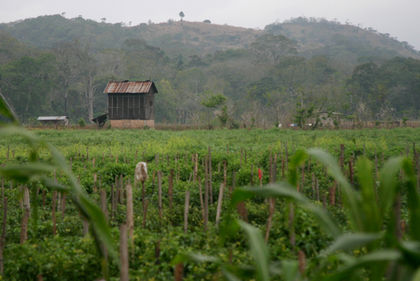
Photo by: Shawn
Talbot
In 1998, only about 17.5% of the total land area of Guatemala was used for
the production of annual or perennial crops, although almost two-thirds is
suitable for crop or pasture use. Agriculture contributes about 23% to GDP,
makes up 75% of export earnings, and employs 50% of the labor force. The
principal cash crops are coffee, sugar, bananas, and cotton, followed by hemp,
essential oils, and cacao. Coffee is grown on highland plantations; most of the
bananas are produced along the Atlantic coastal plain. Cash crop output in 1999
included 15,459,000 tons of sugarcane, 200,000 tons of coffee, 3,000 tons of
cotton, and 733,000 tons of bananas. Subsistence crop production included
1,109,000 tons of corn and 93,000 tons of dry beans, along with rice, wheat, and
fruits and vegetables. Nontraditional agricultural exports have greatly
increased in recent years; such products include: lychee, rambutan, melon,
papaya, mango, pineapple, broccoli, okra, snow peas, celery, cauliflower,
asparagus, garlic, spices and nuts, and ornamental plants. Guatemala's trade
surplus in agricultural products was $488.4 million in 2001.
An agrarian reform law of 1952 provided for government expropriation of unused privately owned agricultural lands, with the exception of farms of 91 hectares (225 acres) or less and those up to 273 hectares (675 acres) if two-thirds of the acreage was under cultivation. By 1954/55, 24,836 hectares (61,371 acres) had been distributed to 10,359 farmers. The law of 1952 was supplemented by an agrarian reform law of 1956, which aimed to distribute state-owned farms (fincas nacionales) to landless peasants. From 1954 to 1962, the government distributed 17,346 land titles. In 1962, the National Agrarian Improvement Institute was created to provide assistance to the new landowners and to improve their living standards. The government requires plantation owners to set aside land for the raising of subsistence crops for their tenants. An agrarian credit bank provides loans to small farmers. Some of the land farmed by Amerindians is held in common by groups of families and is never sold.
An agrarian reform law of 1952 provided for government expropriation of unused privately owned agricultural lands, with the exception of farms of 91 hectares (225 acres) or less and those up to 273 hectares (675 acres) if two-thirds of the acreage was under cultivation. By 1954/55, 24,836 hectares (61,371 acres) had been distributed to 10,359 farmers. The law of 1952 was supplemented by an agrarian reform law of 1956, which aimed to distribute state-owned farms (fincas nacionales) to landless peasants. From 1954 to 1962, the government distributed 17,346 land titles. In 1962, the National Agrarian Improvement Institute was created to provide assistance to the new landowners and to improve their living standards. The government requires plantation owners to set aside land for the raising of subsistence crops for their tenants. An agrarian credit bank provides loans to small farmers. Some of the land farmed by Amerindians is held in common by groups of families and is never sold.